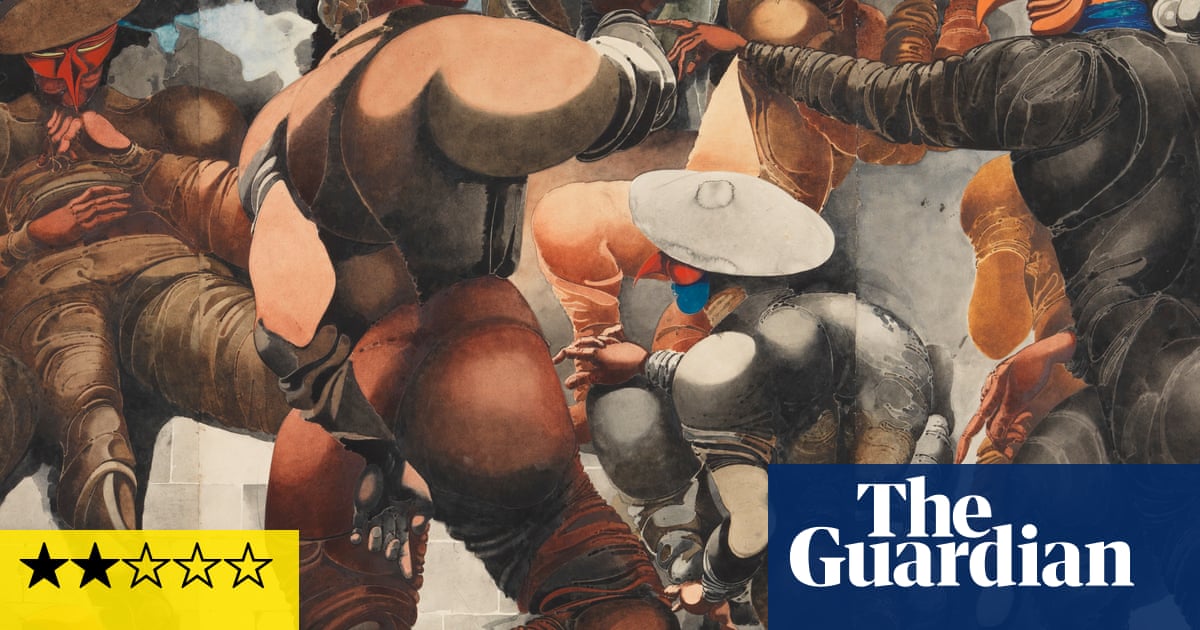They make a truly odd couple. She’s an occultist who once appeared on BBC television explaining to the nation how to make surrealist art at home. He’s a jazz enthusiast whose slices of modern – and often queer - life are full of roly-poly grotesques. What on earth have Ithell Colquhoun and Edward Burra got in common, and why hasTate Britainhandcuffed them together for an uncalled for, unneeded and ultimately baffling double header?
I loved Colquhoun’s exhibition at Tate St Ives when Ireviewedit earlier this year, but this version of it is much more flatly laid out and her experiments in releasing the unconscious are shouted down by all the drunken, drugged, omnivorously shagging people in Burra’s 1920s and 30s clubs and bars. Yet he also gets edited and reinvented in a way that left me largely cold.
Burra was modern but reactionary, a brilliant social observer who also retreated into a private world in his hideaway in Rye, Sussex. This exhibition claims his art is largely about “queer culture” yet his actual sexuality is mysterious – not that you’d know that from the show. He painted in watercolour, wildly stretching this medium’s possibilities. He is an odd, cussed, unique figure.
How reactionary? Well,he sympathisedwith General Franco’s far-right forces in the Spanish civil war. He didn’t share thewidespread beliefof his generation that the Spanish fight was a struggle for humanity’s future against the rising forces of fascism. Yet Tate Britain puts Burra’s Spanish civil war art at the heart of its fitful show without acknowledging his well-known position. In fact it goes further and tries to present him as a great artist of modern conflict.
I don’t see it. Burra’s big, busy, booming watercolours seem to treat the war as a gaudy spectacle, a horrorshow ballet, and have more pity for broken architecture than slaughtered people. Harlequins and devils cavort in the ruins but there is no precision about the war’s victims – look to Picasso’s Guernica for them.
In Burra’s Beelzebub, a naked big-bummed devil presides with sensual joy over a nude battle of muscular erotic soldiers in a crumbling bombed-out cathedral: an emphasis on the destruction of churches and killing of clergy as supposed leftist atrocities was typical of pro-Franco imagery. A wall text quotes Burra on the eve of the war: “It was terrifying: constant strikes, churches on fire, and pent up hatred everywhere.” It is the hatefulness he sees in the Spanish workers and Republicans he’s condemning, with their strikes and anti-clericalism.
Burra was out of his depth. He was a party animal not a political pundit. In its first couple of rooms, this show reveals how wondrously hedonistic he can be. In his depictions of Paris nightlife in the late 1920s he is amazed and delighted by French freedom. Women do naked erotic dances at the Folies de Belleville, men dance with men and women with women at a dance hall, and sailors chat each other up at a bar.
The exhibition, structured as a series of highlights from his career, doesn’t explain how Burra, born in 1905, came by his singular style, at once precise, comic, sensual and grotesque. But by the time he went to France it was fully formed. Hogarth was one source. The British tradition of caricature dynamises The Tea Shop, from 1929, in which two prudishly polite women in the foreground, one in spectacles that stress her myopia, look idiotically at us, unaware that the waiting staff behind them, male and female, are stark naked. They’re a couple of squares who don’t get the 20s scene.
Sign up toArt Weekly
Your weekly art world round-up, sketching out all the biggest stories, scandals and exhibitions
after newsletter promotion
Burra was plugged in to that scene, internationally. Though based in tranquil Rye and suffering with rheumatoid arthritis, he would go anywhere for fun. The jazz records he loved are on show – and playing distractingly – and in his paintings of New York and other US cities, jazz and queerness lead him to riotous venues where you might not have met many white Englishmen. In his 1937 picture Izzy Orts, he takes you to the heart of the night where a sailor stares at you with white, pupil-less eyes, as if in ecstasy. At the rear of the crowd you see Burra himself, his pupils also on the point of vanishing. You can hear the noise, smell the smoke, anticipate, as Burra seems to, the sex.
Yet this exhibition insists on sentimentalising him. Burra’s paintings of African Americans are presented as acts of allyship with the Harlem Renaissance, but he wasn’t doing portraits of Langston Hughes or hanging out with Zora Neale Hurston. His Harlem scenes are Hogarthian city scenes bursting with raw reality and like any caricaturist he’s ambivalent. Is he celebrating the tall, bandy legged man smoking in the street with a white eye showing under his green hat, or mocking him?
The most pleasurable works in Burra’s show are his late landscapes of green rolling Sussex hills which swallow you up. These paintings also depict petrol stations and other modern blights wrecking his beloved countryside, but it seems not just a stretch but nonsensical for a wall text to claim he was “prescient” about the climate crisis. Was he an occultist like Colquhoun after all, gazing into his crystal ball? Tate Britain creates a fantasy version of Burra, removing his complexities, turning a genuinely important artist into a plastic fiction. Pity the museum that needs heroes.
Edward Burra-Ithell Colquhoun is atTate Britain, London, from 13 June to 19 October
